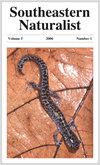路边人工湿地中木鹳猎物生物量的影响因素
IF 0.4
4区 环境科学与生态学
Q4 BIODIVERSITY CONSERVATION
引用次数: 1
摘要
与人口增长相关的基础设施破坏了水文模式,并影响了美洲分枝杆菌(木鹳)等湿地物种。然而,人们经常观察到鹳在人造湿地的道路上觅食,并在城市环境中筑巢,这表明这些地区可能提供了新的觅食栖息地。我们对永久淹没和短暂创造的湿地进行了采样,以确定哪些水文、植被和物理属性与高鹳猎物生物量有关。影响鹳猎物生物量的因素在永久淹没和短暂创造的湿地之间存在差异。景观水平的植被和湿地的物理性质对永久淹没的池塘和沟渠的影响更大,而局地尺度的植被和水文条件对短暂的池塘和沟渠的影响最大。此外,永久淹没人工湿地的水生动物生物量是天然湿地的9倍,城市景观中的水生动物生物量甚至更大。这些发现表明,人造湿地可能为林鹳提供了额外的觅食栖息地。随着自然湿地的不断丧失和人为管理,人造湿地应该被考虑到保护计划和未来管理决策中,因为木鹳和其他涉水鸟类有能力生产涉水鸟类的猎物。本文章由计算机程序翻译,如有差异,请以英文原文为准。
Factors Influencing Wood Stork Prey Biomass in Roadside Created Wetlands
Abstract - Infrastructure associated with a growing human population has disrupted hydrologic patterns and impacted wetland species such as Mycteria americana (Wood Stork). However, storks are commonly observed foraging along roadways in created wetlands and nesting in urban environments, suggesting that these areas may provide novel foraging habitat. We sampled both permanently inundated and ephemeral created wetlands to determine which hydrologic, vegetative, and physical attributes are associated with high stork prey biomass. Factors influencing stork prey biomass differed between permanently inundated and ephemeral created wetlands. Landscape-level vegetation and the physical properties of a wetland were more influential in permanently inundated ponds and canals whereas local-scale vegetation and hydrologic conditions were most influential in ephemeral ponds and swales. Furthermore, aquatic fauna biomass in permanently inundated created wetlands was 9x greater than in natural wetlands, and aquatic fauna biomass was even greater in the urban landscape. These findings suggest that created wetlands may serve as additional foraging habitat for Wood Storks. As natural wetlands continue to be lost and managed for human purposes, created wetlands should be considered in conservation plans and future management decisions for Wood Storks and other wading birds given their ability to produce wading bird prey.
求助全文
通过发布文献求助,成功后即可免费获取论文全文。
去求助
来源期刊

Southeastern Naturalist
环境科学-生态学
CiteScore
1.20
自引率
16.70%
发文量
31
审稿时长
18-36 weeks
期刊介绍:
The Southeastern Naturalist covers all aspects of the natural history sciences of terrestrial, freshwater, and marine organisms and the environments of the southeastern portion of North America, roughly bounded from North Carolina south to Florida, west to Texas, north to Oklahoma, and east back to North Carolina. Manuscripts based on field studies outside of this region that provide information on species within this region may be considered at the Editor’s discretion.
 求助内容:
求助内容: 应助结果提醒方式:
应助结果提醒方式:


